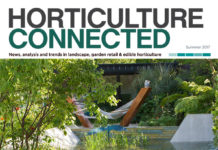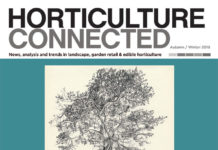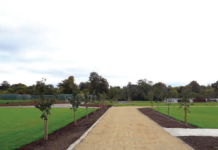Why Irish designers should be making more of Irish nurseriesIt’s a problem as old as our sector, a divide between those that grow plants and those that specify plants. We’ve talked about it before in these pages, attempted to tease out the problems and forge better relationships between the various parties involved in the creation of gardens and landscapes in Ireland. We’ve not been successful in our endeavours and despite some excellent examples of best practice relationships between growers and specifiers, generally speaking, the problems persist. Not to be defeated, we have decided to include a two-part article with views from each camp. In this first part, we asked several high-profile nursery operators to state how they think designers should be better using the services and products they have on offer. In the next issue, we will ask the specifying community how nurseries can better engage with them. Many thanks to those who took the time to contribute. |
EARLY ENGAGEMENT PRODUCES BETTER RESULTS
JOHN MURPHY, ANNAVEIGH PLANTS
As a group, Architects and designers generally wish to push out the bounds of landscape fashion. Unfortunately, in most cases, this doesn’t suit the Irish nurseries. The overall market in Ireland is small and due to economies of scale, nurseries must concentrate their production on those items that sell in numbers. Whilst we have some specialised nurseries the numbers produced are generally small and get used up very quickly. So how do the designers make more of Irish nurseries?
Obviously, the first advice I would give is to visit the nurseries and see what is on offer. Progressive growers will always have something new and we often see our plants appearing in specifications after visits. Crops vary widely in quality and it’s often beneficial to know who has the best products and specify from these. Visiting nurseries and meeting the people will give you a better concept of what they can or cannot offer. Also, try to visit projects the nursery has supplied to be sure they are up to the task.
Involve the nurseries from the beginning of the concept. Recently we have been working with a landscape firm who always push out the boundaries when it comes to plants. I was having difficulty finding some of the stock and spoke to the Architect and received a concept drawing of the project. Immediately I understood what they were looking for and was able to recommend alternatives for the difficult to find items. The Architect was happy and we got to use more of our product. I sourced the rest of it overseas.
Many Architects and designers now send us the proposed bill of quantities prior to the tender stage, asking us to check the availability of the plants and sizes specified and to suggest alternatives if supply is a problem. This is where a good relationship with the nursery is important. It would be very easy for us to say this and that are not available and to try to push what we grow. If a nursery is going to be any good for the Architect or designer then the salespeople must have a truly universal understanding of plant supply. They need to have a complete knowledge of the European market and know the best nurseries and use their knowledge to find the most obscure requests.
Often the nurseries are seen as just another supplier into most developments but involving them from the start of a project can have a big influence on the outcome. During the last three years, we have been involved in major and complex projects such as Adare Manor Hotel, No.1 Ballsbridge and the restoration of the gardens in Hillsborough Castle. In many cases we were brought on board by the landscape contractors from the start and through this developed a relationship with the Landscape Architects. The result was that the contractor was happy to let us deal directly with the Architect and sort out any supply problems and source material for the projects as they evolved. We also organised and handled the overseas nursery visits, leaving the contractor free to get on with the job.
In a simpler way, most nurseries have a vast knowledge of what will grow and not grow in demanding sites. We are often tasked with suggesting a range of products for different locations and are happy to help out where we can. Another simple way of using the nurseries more is through images. Requests come in for photos every day and it has become a major sales tool for our company, especially when dealing with large or unusually shaped plants.
It’s impossible to grow everything required for landscape planting, and as a result, most nurseries are involved in importing. Each season we bring Architects and designers abroad so as they can choose the best plants available. This year we have been overseas with Architects and designers seven times marking stock for projects as far ahead as 2021. Using the nurseries to organise visits to overseas producers ensures only the best nurseries are visited and apart from the immediate project involved gives Architects and designers a much better view of what is available for future work. ✽
WE DON’T BITENUALA YOUNG, YOUNG’S NURSERIES The most beneficial thing any plant specifier can do is make time to visit nurseries. I cannot overemphasize how important this is. In my years of experience, I’ve not seen anything else that had such a huge impact. It’s like a light switch being turned on. We enjoy nothing more than making time for specifiers and helping them on a one to one basis. Every specifier that has ever visited us always leaves saying the same thing: “I wish I’d done this years ago.” If you are planning to visit a nursery, make a day of it and try to take in a few different suppliers. Call ahead to ensure someone will be on hand to provide any information needed. If you are visiting in relation to a specific project, plan as far in advance as possible. I know it’s not always possible but realistically the earlier you visit the better. If it’s a show garden you’re creating, give yourself 12 months in advance rather than the usual 12 days. When you come to specifying plants, make a couple of calls and check availability, ask for possible substitutions. Let your nursery do the hard work at the start so you can get what you want and you won’t leave clients disappointed. Consider geographic location. Plants sourced closer to their destination can often increase establishment rates. You might buy something cheaper from abroad but that’s a false economy if they won’t thrive in the planting location. Ask your nursery supplier to advise you on establishment rates for particular plants in different counties; a plant that grows well in Dublin might not last a season in the Midlands. Always ask. Build a working relationship with nurseries you trust. This starts with a visit so you can understand working practices, quality, scale, services and so on. Be honest with nursery owners, we don’t bite and we won’t hold it against you if you can name as many plants as we can! Don’t be afraid to ask about the basics, what we think of the plants being specified, what we might recommend, planting styles, densities, colour combinations etc. Plants are our lives, you can’t be expected to know everything and we’re more than happy to help. Here at Young Nurseries, we are constantly developing new product lines and improved varieties to add to our extensive range of perennials. We completed a new state of the art greenhouse in 2017 with phase 2 due to begin later in 2018, this has allowed us to meet extra demand for new lines and capacity to supply large volume in busy periods. Our plants are biologically grown using environmentally friendly practices. We have an integrated pest management system in place (IPM) and we do not use neonicotinoids. ✽ |
MATCHING CREATIVITY WITH TECHNICAL KNOWLEDGE
DAGMARA STRACHOTA, TOBY SMITH, JONATHAN FOX OF TULLY NURSERIES
We believe that a good working knowledge of horticultural practices and plant availability in the market is essential to be a successful designer and we as a supplier need to work closely with Landscape Architects, garden designers, landscape contractor and local authorities knowing that each group of our clients has different needs and wants. In order to find out what our clients require we have to ask them and work with them to improve our product offering and to match it with what the industry needs.
Our open days have helped us obtain knowledge of what our clients are looking for, which plants work successfully in our climate and at the same time, they can view our grown stock which is a combination of their feedback and our visits to suppliers and trade shows in Europe. Clients can also familiarise themselves with some imported stock ready to be viewed and inspected. We highly recommend our clients to visit us when it suits them or during our open days, which can be organised on special request. It’s extremely important for people to visit suppliers regularly to look at changes in product ranges. We do this ourselves with our suppliers and no matter how often you visit someone you always learn something new. This is the only way to share not only theoretical knowledge but also practical experience. Our team attends GLDA seminars and ALCI meetings to understand current trends better.
In our opinion, creativity is as important as the practical side of the design which is why we travel abroad to find some unusual plants and shapes to suit the most demanding gardens. By assisting us in foreign visits clients can discover new shapes and forms of plants and include them in some of their designs. That can work very well if clients are giving themselves enough time for a sourcing process, inspection, deliveries, etc. We highly recommend planning in advance, allowing plenty of time to share your ideas with us. We are always ready to advise our clients on what can be sourced, provide pictures and full plant descriptions if needed. Otherwise, they can trust our experts who always handpick the stock for the big projects. Our quality manager makes sure you receive a plant according to the specification and particularly that tree girth is correctly measured and supplied. To raise the quality of the industry in Ireland everyone has a role to play in checking standards and sizes and ensuring that when a nursery supplies a batch of 10/12 trees they are all the correct size and grown to ENA standards. As an experienced nursery, we buy plants only from the best growers, where we can obtain certificates and plant passports, and where we have confidence that our suppliers take the source of their stock seriously and will not risk buying or selling stock from unknown sources. Cooperating with a nursery that designers can trust gives them more time to spend with clients, engineers, and building Architects; this is key to understanding a project and to meeting everyone’s expectations. Dealing with a professional sales person in the nursery helps enormously in preparing site plans, specifications, and cost estimates.
Irish nurseries are full of passionate plantspeople who grow high-quality stock and are amazing plants advisors. Taking time to explore nurseries first hand and meeting nursery people face to face are the keys to understanding what they can provide.
As a company that has been in business for over 30 years and experienced the highs and lows of the economy, we know that being progressive is the way to ensure a striving business. Our tagline ‘’Your ideas, our expertise’’ sums up our collaborative approach to working with the industry. ✽
BIOSECURING OUR FUTURERONAN NANGLE, NANGLE AND NIESEN In an ideal world, for both designers/Landscape Architects and Irish growers, each tree would be handpicked and tagged individually in the nursery. Designers/Landscape Architects would come to the nursery and select from the available stock, thus ensuring that they get what they want from a quality and aesthetic perspective. Tenders would not be adjudicated solely on price, rather they would be awarded based on quality and suitability. Clients would understand that quality and sustainability are ultimately what matter and not bottom line costs. Unfortunately, we don’t live in that ideal world. However, we do live in a world where it is vital that our clients come to visit us on a regular basis if possible. Be they landscapers, Architects, designers or public authorities, a visit to the nursery is of huge benefit to everyone. If this happens, the decision makers can see what is available in the Irish nurseries, what looks good and what does well in Irish conditions. This leads to informed decision making, better specification and better pricing if you don’t have to import. The classic example of this in the last number of years is the excessive demand for Pyrus calleryana ‘Chanticleer’, which is in short supply in the bigger sizes throughout Europe and not available in any of the nurseries in Ireland, and yet still appears on most landscape schemes in these larger sizes. All designers want to push the boundaries in their work, to look for something different that will raise the standards and look spectacular. It is our job to give them the materials to do so. I would love it if we had everything in our own nursery, but of course, that will never be the case. All of us growers spend weeks visiting the Continent sourcing the best suppliers for different material. Ever more frequently we are bringing the clients with us to meet the growers to ensure that they are happy with the plant quality. I do feel, however, that this decision to search abroad could often be avoided in a lot of cases by sourcing locally. Again, visiting Irish nurseries and talking to the growers would have a hugely positive impact on everyone, and building the relationship between the specifier and the grower is vital going forward. The most satisfied clients I work with continually seek advice about what is available and what can be used as substitutes, often before the specification is done. I recently completed a large project with Adare Manor where the client visited the nursery four times to select the trees individually. The result was that of the 147 extra large trees (50-90cm girth) planted on site there were no failures – an extraordinary result for trees that size. There are also other issues at stake. I recently attended a conference at Highgrove House in Gloucestershire with growers and buyers from the UK and around Europe. The topic was plants health and biosecurity. The bomb has already exploded in relation to ash dieback, but the real damage has yet to happen. It was very obvious that the focus of UK buyers has shifted and in the next few years, we are going to see much more emphasis on plant origin, traceability and plant health. UK buyers want to stop buying from Italy and Holland and ring-fence the UK oak fortress. That may be unrealistic but is indicative of the prevailing mood. Using Irish nurseries to select your trees increases our national biosecurity and lessens the risk of importing stock with Xylella, Chalara fraxinea, oak processionary moth or any of the other pests and diseases that are wreaking havoc across Europe. Both parties, nurseries and buyers, will have to take this into account when planting up our stock and when specifying trees that can only be sourced in Europe. The number of tree growers in Ireland is small, but we are all experienced, have high standards and excel at what we do. We have to shout about this more and get people down to our nurseries on a more regular basis. As growers, we go to extraordinary lengths to source and grow fantastic specimens that would grace any garden in Europe. I have yet to show somebody around who hasn’t been blown away by what they have seen. Everyone is extremely busy and time is scarce but if the buyers could make it part of their schedule to visit some of the Irish nurseries every year then I think that growers, buyers, clients, the landscape and the biosecurity of the country as a whole, will benefit. ✽ |








